
Unas or Wenis, also spelled Unis, was a pharaoh, the ninth and last ruler of the Fifth Dynasty of Egypt during the Old Kingdom. Unas reigned for 15 to 30 years in the mid-24th century BC, succeeding Djedkare Isesi, who might have been his father.

Neferneferuaten Nefertiti was an Egyptian queen and the Great Royal Wife of Akhenaten, an Egyptian Pharaoh. Nefertiti and her husband were known for a religious revolution, in which they worshipped one god only, Aten, or the sun disc. With her husband, she reigned at what was arguably the wealthiest period of Ancient Egyptian history. Some scholars believe that Nefertiti ruled briefly as Neferneferuaten after her husband's death and before the accession of Tutankhamun, although this identification is a matter of ongoing debate. If Nefertiti did rule as Pharaoh, her reign was marked by the fall of Amarna and relocation of the capital back to the traditional city of Thebes.
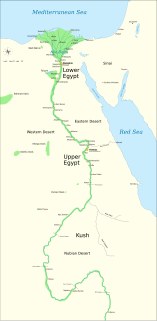
In ancient Egyptian history, the Old Kingdom is the period spanning c. 2686–2181 BC. It is also known as the "Age of the Pyramids" or the "Age of the Pyramid Builders", as it encompasses the reigns of the great pyramid builders of the Fourth Dynasty— among them King Sneferu, who perfected the art of pyramid-building, and the kings Khufu, Khafre and Menkaure, who constructed the pyramids at Giza. Egypt attained its first sustained peak of civilization during the Old Kingdom—the first of three so-called "Kingdom" periods which mark the high points of civilization in the lower Nile Valley.

Kiya was one of the wives of the Egyptian Pharaoh Akhenaten. Little is known about her, and her actions and roles are poorly documented in the historical record, in contrast to those of Akhenaten's first royal wife, Nefertiti. Her unusual name suggests that she may originally have been a Mitanni princess. Surviving evidence demonstrates that Kiya was an important figure at Akhenaten's court during the middle years of his reign, when she bore him a daughter. She disappears from history a few years before her royal husband's death. In previous years, she was thought to be mother of Tutankhamun, but recent DNA evidence suggests this is unlikely.

Pepi II was a pharaoh of the Sixth Dynasty in Egypt's Old Kingdom who reigned from c. 2278 BC. His throne name, Neferkare (Nefer-ka-Re), means "Beautiful is the Ka of Re". He succeeded to the throne at age six, after the death of Merenre I.

Ahmose-Nefertari of Ancient Egypt was the first queen of the 18th Dynasty. She was a daughter of Seqenenre Tao and Ahhotep I, and royal sister and the great royal wife of Ahmose I. She was the mother of king Amenhotep I and may have served as his regent when he was young. Ahmose-Nefertari was deified after her death.
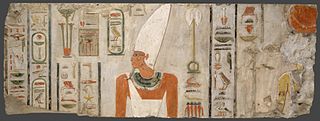
Nebhepetre Mentuhotep II was a Pharaoh of the 11th Dynasty who reigned for 51 years. Around his 39th year on the throne he reunited Egypt, thus ending the First Intermediate Period. Consequently, he is considered the first pharaoh of the Middle Kingdom.

Menkauhor Kaiu was an Ancient Egyptian pharaoh of the Old Kingdom period. He was the seventh ruler of the Fifth Dynasty at the end of the 25th century BC or early in the 24th century BC.
Intef III was the third pharaoh of the Eleventh Dynasty of Egypt during the late First Intermediate Period in the 21st century BC, at a time when Egypt was divided in two kingdoms. The son of his predecessor Intef II and father of his successor Mentuhotep II, Intef III reigned for 8 years over Upper Egypt and extended his domain North against the 10th Dynasty state, perhaps as far north as the 17th nome. He undertook some building activity on Elephantine. Intef III is buried in a large saff tomb at El-Tarif known as Saff el-Barqa.
The Amarna Period was an era of Egyptian history during the later half of the Eighteenth Dynasty when the royal residence of the pharaoh and his queen was shifted to Akhetaten in what is now Amarna. It was marked by the reign of Amenhotep IV, who changed his name to Akhenaten in order to reflect the dramatic change of Egypt's polytheistic religion into one where the sun disc Aten was worshipped over all other gods. Aten was not solely worshipped, but the other gods were worshipped to a significantly lesser degree. The Egyptian pantheon of the equality of all gods and goddesses was restored under Akhenaten's successor, Tutankhamun.
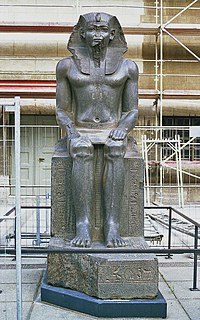
Nubkaure Amenemhat II was the third pharaoh of the 12th Dynasty of Ancient Egypt. Although he ruled for at least 35 years, his reign is rather obscure, as well as his family relationships.

Nyuserre Ini was an Ancient Egyptian pharaoh, the sixth ruler of the Fifth Dynasty during the Old Kingdom period. He is credited with a reign of 24 to 35 years depending on the scholar, and likely lived in the second half of the 25th century BCE. Nyuserre was the younger son of Neferirkare Kakai and queen Khentkaus II, and the brother of the short-lived king Neferefre. He may have succeeded his brother directly, as indicated by much later historical sources. Alternatively, Shepseskare may have reigned between the two as advocated by Miroslav Verner, albeit only for a few weeks or months at the most. The relation of Shepseskare with Neferefre and Nyuserre remains highly uncertain. Nyuserre was in turn succeeded by Menkauhor Kaiu, who could have been his nephew and a son of Neferefre.
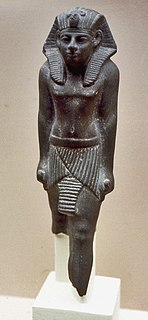
Merankhre Mentuhotep VI was a Theban king of the 16th dynasty based in Upper Egypt during the Second Intermediate Period. He was perhaps the 14th king of the dynasty.

Khasekhemre Neferhotep I was an Egyptian pharaoh of the mid Thirteenth Dynasty ruling in the second half of the 18th century BC during a time referred to as the late Middle Kingdom or early Second Intermediate Period, depending on the scholar. One of the best attested rulers of the 13th Dynasty, Neferhotep I reigned for 11 years.
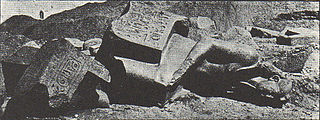
Smenkhkare Imyremeshaw was an Egyptian pharaoh of the mid 13th dynasty during the Second Intermediate Period. Imyremeshaw reigned from Memphis, starting in 1759 BC or 1711 BC. The length of his reign is not known for certain; he may have reigned for 5 years and certainly less than 10 years. Imyremeshaw is attested by two colossal statues now in the Egyptian Museum, Cairo.

Merhotepre Ini was the successor of Merneferre Ay, possibly his son, and the thirty-third king of the Thirteenth Dynasty of Egypt. He is assigned a brief reign of 2 Years, 3 or 4 Months and 9 days in the Turin Canon and lived during the early 17th century BC.
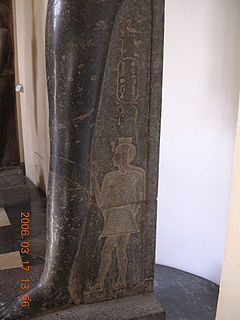
Henutmire was an Ancient Egyptian princess and queen. She was one of the eight Great Royal Wives of Pharaoh Ramesses II of the 19th Dynasty of Egypt.
Sewadjenre Nebiryraw was an ancient Egyptian pharaoh of the Theban-based 16th Dynasty, during the Second Intermediate Period.
Nubhetepti(nb-ḥtp.tỉ, „Gold [=Hathor] is satisfied”) was an Ancient Egyptian queen with the titles king's wife and king's mother. She is mainly known from scarab seals, which are datable by style to the 13th Dynasty, around 1750 BC. She is also known from a statuette found at Semna. Her husband is unknown. However, king Hor had a daughter called Nubhetepti-khered. This translates as Nubhetepti-the-child and indicates that there was another (older) Nubhetepti around at the same time. For that reason it has been argued that Nubhetepti was the wife of king Hor and perhaps the mother of the princess Nubhetepti-khered. There are other scarabs of a queen Nubhetepti with the titles Great Royal Wife and she united with the white crown. These scarabs belong perhaps to another queen with the same name.
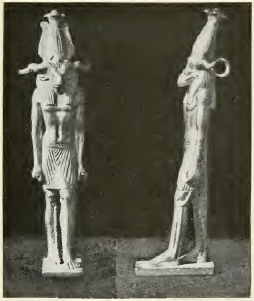
Peftjauawybast or Peftjaubast was an ancient Egyptian ruler ("king") of Herakleopolis Magna during the 25th Dynasty.